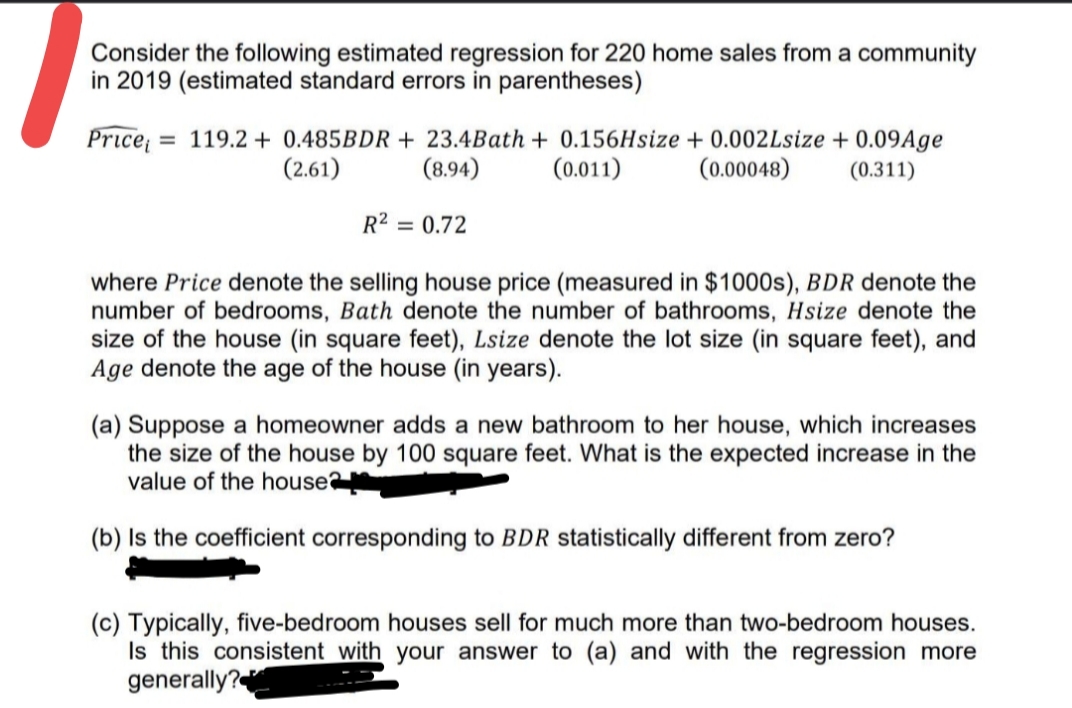Consider the following estimated regression for 220 home sales from a community in 2019 (estimated standard errors in parentheses) Price = 119.2 + 0.485BDR + 23.4Bath + 0.156Hsize + 0.002Lsize + 0.09Age (8.94) (2.61) (0.011) (0.00048) (0.311) R2 = 0.72 where Price denote the selling house price (measured in $1000s), BDR denote the number of bedrooms, Bath denote the number of bathrooms, Hsize denote the size of the house (in square feet), Lsize denote the lot size (in square feet), and Age denote the age of the house (in years). (a) Suppose a homeowner adds a new bathroom to her house, which increases the size of the house by 100 square feet. What is the expected increase in the value of the house (b) Is the coefficient corresponding to BDR statistically different from zero? (c) Typically, five-bedroom houses sell for much more than two-bedroom houses. Is this consistent with your answer to (a) and with the regression more generally?
Consider the following estimated regression for 220 home sales from a community in 2019 (estimated standard errors in parentheses) Price = 119.2 + 0.485BDR + 23.4Bath + 0.156Hsize + 0.002Lsize + 0.09Age (8.94) (2.61) (0.011) (0.00048) (0.311) R2 = 0.72 where Price denote the selling house price (measured in $1000s), BDR denote the number of bedrooms, Bath denote the number of bathrooms, Hsize denote the size of the house (in square feet), Lsize denote the lot size (in square feet), and Age denote the age of the house (in years). (a) Suppose a homeowner adds a new bathroom to her house, which increases the size of the house by 100 square feet. What is the expected increase in the value of the house (b) Is the coefficient corresponding to BDR statistically different from zero? (c) Typically, five-bedroom houses sell for much more than two-bedroom houses. Is this consistent with your answer to (a) and with the regression more generally?
Glencoe Algebra 1, Student Edition, 9780079039897, 0079039898, 2018
18th Edition
ISBN:9780079039897
Author:Carter
Publisher:Carter
Chapter4: Equations Of Linear Functions
Section4.6: Regression And Median-fit Lines
Problem 4GP
Related questions
Question

Transcribed Image Text:Consider the following estimated regression for 220 home sales from a community
in 2019 (estimated standard errors in parentheses)
Price
= 119.2 + 0.485BDR + 23.4Bath + 0.156Hsize + 0.002Lsize + 0.09Age
(0.011)
(2.61)
(8.94)
(0.00048)
(0.311)
R² = 0.72
where Price denote the selling house price (measured in $1000s), BDR denote the
number of bedrooms, Bath denote the number of bathrooms, Hsize denote the
size of the house (in square feet), Lsize denote the lot size (in square feet), and
Age denote the age of the house (in years).
(a) Suppose a homeowner adds a new bathroom to her house, which increases
the size of the house by 100 square feet. What is the expected increase in the
value of the house
(b) Is the coefficient corresponding to BDR statistically different from zero?
(c) Typically, five-bedroom houses sell for much more than two-bedroom houses.
Is this consistent with your answer to (a) and with the regression more
generally?
Expert Solution
This question has been solved!
Explore an expertly crafted, step-by-step solution for a thorough understanding of key concepts.
Step by step
Solved in 4 steps

Recommended textbooks for you

Glencoe Algebra 1, Student Edition, 9780079039897…
Algebra
ISBN:
9780079039897
Author:
Carter
Publisher:
McGraw Hill

Glencoe Algebra 1, Student Edition, 9780079039897…
Algebra
ISBN:
9780079039897
Author:
Carter
Publisher:
McGraw Hill